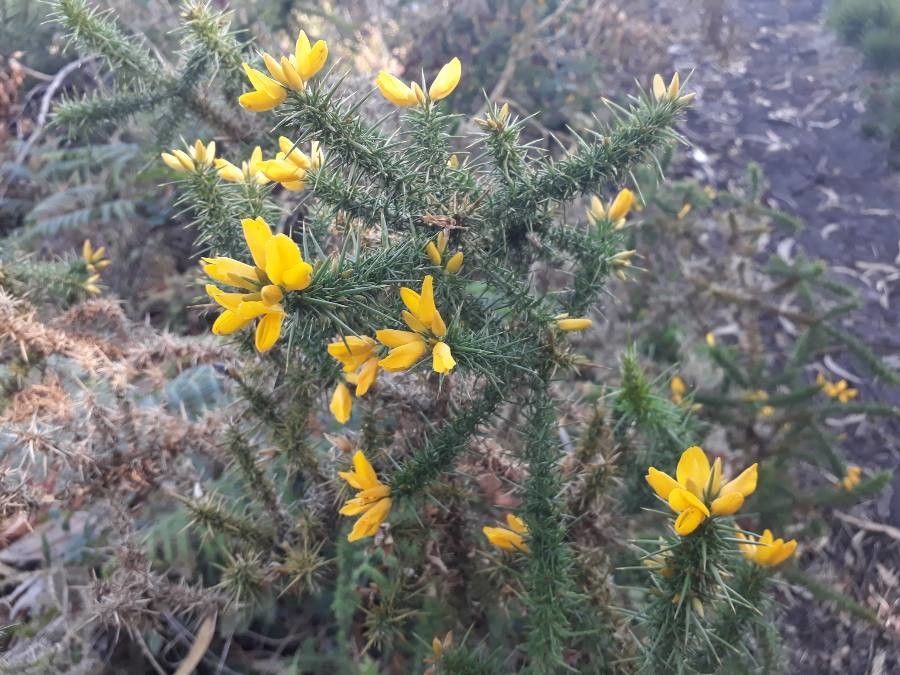Dwarf Furze
ulex minor
Also known as: ["Dwarf Gorse","Small Furze"]
Overview
A low-growing, spiny shrub native to Western Europe, characterized by yellow flowers and hard, green stems.
Benefits & Perks
["drought tolerant","wildlife attractant (bees, butterflies, birds)"]
Botanical Classification
| Phylum: | Magnoliophyta |
| Class: | Magnoliopsida |
| Order: | Fabales |
| Family: | Fabaceae |
| Genus: | Ulex |
| Botanical Name: | Ulex minor |
Plant Characteristics
Basic Information
- Category: Shrubs
- Suitable Location: rock garden, coastal areas, or open ground in full sun
- Suitable For:
- Is Weed: No
- Allergenicity: low
Environmental Needs
- Climate: {"temperatureRange":"5–30°C"}
- Hardiness: {"zones":"7–10"}
- Misting: rarely required
- Drainage: Fast-draining to prevent root rot.
- Soil Type: Well-draining, sandy, or loamy soil with low fertility.
Maintenance Level
- Maintenance Level: low
- Toughness Level: high
- Pruning Frequency: Annually in late winter or early spring before new growth begins.
- Pruning Intensity: Moderate to heavy, depending on desired shape and size.
Care Details
Ideal Sunlight Coverage:
Full sun (6–8 hours/day). Tolerates partial shade but blooms best in direct light.
Sunlight Tolerance Tips:
Acclimate gradually if moving from shade to sun; protect from intense midday sun in hot climates; ensure good air circulation to prevent fungal issues.
Care Requirements
Care Difficulty
moderatemoderate
Sunlight
full sun
Full sun exposure; rotate regularly; avoid deep shade.
Watering
every 7–10 days during active growth, less frequently in winter
Water deeply but infrequently; avoid waterlogged soil; adjust for seasons.
Soil
well-drained, sandy or loamy soil
pH: Acidic to neutral (pH 5.5–7.0).
Ensure excellent drainage; avoid heavy clay; use acidic soil amendments if needed.
Temperature
Hardy in USDA zones 7–10. Prefers mild temperatures (50–75°F/10–24°C).
Protect from frost; avoid extreme heat; maintain consistent temperatures.
Fertilizing
rarely required, if used then every 3 months with a balanced, slow-release fertilizer
Fertilize sparingly; apply in early spring; avoid high-nitrogen formulas.
Propagation
Methods
Stem cuttings or seed. Stem cuttings are more reliable for home growers.
Step-by-Step Propagation Guide
- Take 4–6 inch cuttings.
- Remove lower leaves.
- Dip in hormone.
- Plant in medium.
- Keep moist.
Best Time: Late spring to early summer when growth is active.
Environment
Warm (65–75°F/18–24°C), high humidity, and partial shade.
Medium
Peat-based mix with perlite or sand for good drainage.
Hormone
Rooting hormone is recommended for faster rooting.
Timeline
Roots in 4–8 weeks; establish in 3–6 months.
Tools Needed
Pruners, rooting hormone, pots, misting spray bottle.
Quick Tips
Use healthy, non-flowering stems; maintain humidity; avoid direct sun.
Pruning & Repotting
Pruning Guide
Method
Cut back stems by one-third to one-half; remove crossing or crowded branches.
Pruning Plan
Prune to maintain shape, encourage bushiness, and remove dead or weak growth.
Tools
Pruning shears, loppers (for larger stems), gloves.
Checklist
Disinfect tools; prune before flowering; remove dead wood; shape evenly.
Repotting Guide
Best Season
Early spring before active growth starts.
Pot Size
One size up (e.g., from 4-inch to 6-inch pot).
Method
Use a well-draining soil mix; gently tease out roots; place in a pot one size larger.
Suggestions
Repot only if necessary, as Ulex minor prefers being slightly root-bound. Typically every 2–3 years.
Checklist
Check root crowding; use fresh soil; ensure drainage; avoid over-potting.
Advanced Care Tips
Watering Mastery
Watering Checklist
Check soil moisture; water deeply; ensure drainage; adjust for season.
How to Apply Water Properly
Water at the base, ensuring moisture reaches the root zone without saturating the soil. Allow excess water to drain away. Water in the morning to minimize evaporation.
Watering Schedule Tips
Water sparingly, allowing soil to dry out between waterings. Reduce frequency in winter to prevent root rot.
Soil Improvement
Add sand or perlite for drainage; incorporate organic matter sparingly.
Temperature Stress Management
Signs of Temperature Issues
Leaf drop, yellowing, or stunted growth in extreme cold or heat.
Cold Stress
Leaves may wilt or turn brown; growth slows or halts in freezing temperatures.
Solution: Mulch heavily in winter; protect from frost; avoid overwatering in cold.
Hot Stress
Wilting, leaf scorch, or reduced flowering in excessive heat.
Solution: Provide afternoon shade; increase watering; use mulch to retain moisture.
Fertilizing Guide
Fertilizing Checklist
Use balanced fertilizer; apply in spring; avoid over-fertilizing.
Fertilizing Method
Use a balanced, slow-release fertilizer in spring. Avoid over-fertilizing, as Ulex minor is adapted to poor soils.
Common Problems & Solutions
Toxicity Warning
Cats
ToxicCats are susceptible to toxicity from Ulex minor due to its alkaloid content. Ingestion can cause severe gastrointestinal and systemic effects, requiring prompt medical intervention.
⚠️ Symptoms:
🌿 Toxic Parts:
⚡ Toxic If:
if eaten
Dogs
ToxicIngestion of Ulex minor by dogs can lead to gastrointestinal upset and systemic toxicity due to the presence of alkaloids. These compounds can disrupt normal metabolic processes in dogs.
⚠️ Symptoms:
🌿 Toxic Parts:
⚡ Toxic If:
if eaten
Humans
ToxicUlex minor contains toxic compounds, primarily alkaloids, which can cause significant physiological disturbances when ingested. These compounds interfere with normal cellular functions and can lead to systemic toxicity.
⚠️ Symptoms:
🌿 Toxic Parts:
⚡ Toxic If:
if eaten
Frequently Asked Questions
Q: Is Ulex minor toxic to pets?
A: Yes, it is toxic to dogs and cats.
Q: Does Ulex minor attract wildlife?
A: Yes, it attracts bees, butterflies, and birds.
Q: How drought-tolerant is Ulex minor?
A: It is highly drought-tolerant and thrives in dry conditions.
Quick Reference
| Family: | Fabaceae |
| Care: | moderate |
| Light: | full sun |
| Water: | every 7–10 days during activ |
Get Expert Care Tips
Download the Plantious app for personalized care reminders and plant identification!
Google Play App Store






